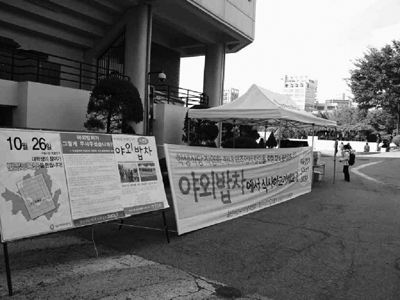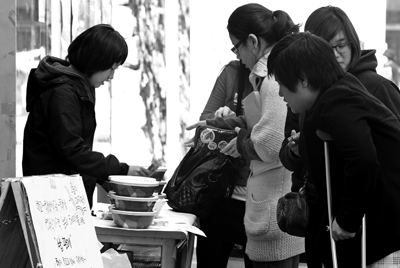

The SGAs of Sookmyung Women’s University and Sogang University boycotted their respective cafeterias by sponsoring campaigns in which they provided Hansot Dosirak meals at a low price to students. Hansot Dosirak is a chain store that sells boxed handmade meals.
The price of cafeteria food ranges from 2,100 won to 2,900 won at Sookmyung Women’s University, and many students are dissatisfied with the overall quality and taste of the meals.
“Our slogan was ‘Boycott cafeteria food for reduced prices through bap-cha (meal cart)’, and it was held from Oct. 17 to Nov. 7. We sold Hansot Dosirak meals with side dishes such as chicken, rice balls, and pork,” said Jeon Hae-kyung (Sookmyung Women’s University, 4), the head of the executive committee of the SGA.
At Sogang University, the meals were sold out for 2,500 won each, the same price as the “special” meal offered at the student cafeteria.
“This boycott was to raise students’ awareness about the cafeteria and put pressure on the school, since it does not share any cafeteria-related information with the students,” said Lee Jon-yong (Sogang University, 3), a member of the SGA at his university.
The movement for half-price meals took the form of a half-price cafe at Korea University. From Oct. 26 to 29, members of Korea University’s SGA sold Americano coffees for 1,000 won each, which ranges from one-fourth to one-third the cost of Americano coffees in many coffee shops. Available for takeout only, this wallet-friendly Americano was welcomed by many students who stopped by to grab a quick cup of coffee before class.
“The cheap price also appealed to many of us, and the taste was fairly decent. It was unnecessary for me to go to a cafe since I could easily get cheap coffee that tasted just as fine,” Yoo Chae-yoon (Korea University, 1) said.
Many of these campaigns have drawn to a close, but students continue to hope that these movements to bring down students’ living costs and meal costs will soon come to a reasonable conclusion as well.
“It will be hard for living costs to decrease drastically right away, but students should be able to study without worrying about the cost,” Yoon Kang-ho (Korea University, 1) said. “I hope more people will become aware that there is plenty of room for improvement on the universities’ side regarding these expenses. I also hope those participating in these campaigns would emphasize eliminating the inflation in the living cost rather than the term ‘half-price’ itself.”
Chung Yoon-young
yychung@ewhain.net

